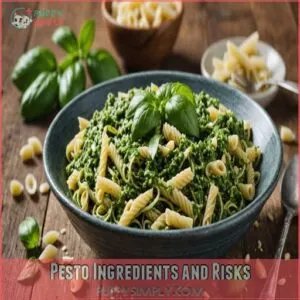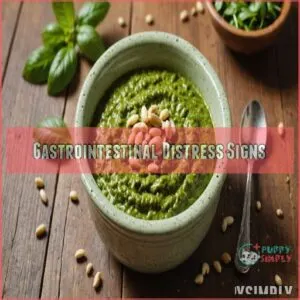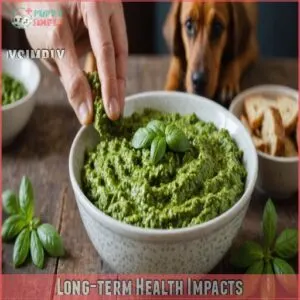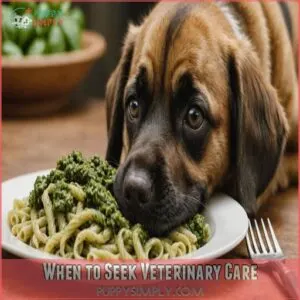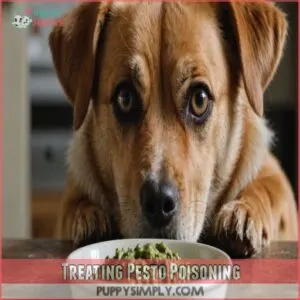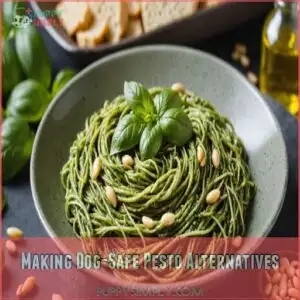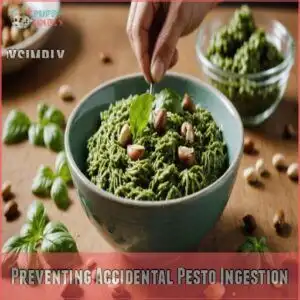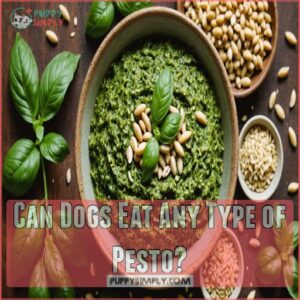This site is supported by our readers. We may earn a commission, at no cost to you, if you purchase through links.
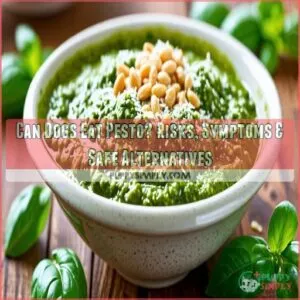 Can dogs eat pesto? In short, no. Pesto might jazz up your pasta, but it’s not dog-friendly.
Can dogs eat pesto? In short, no. Pesto might jazz up your pasta, but it’s not dog-friendly.
Containing garlic, which is downright toxic to dogs, and pine nuts and parmesan, which add unneeded fat, pesto can stir up quite the storm in your pup’s tummy. You could see symptoms from vomiting to diarrhea—none of which make for a happy pet or owner. Even a nibble can lead to long-term issues like pancreatitis.
So, keep that tasty green sauce to yourself. Wondering about safe alternatives? There’s more to sniff out about dog-safe herbs and tips ahead—stay curious!
Table Of Contents
- Key Takeaways
- Pesto Ingredients and Risks
- Symptoms of Pesto Poisoning
- Treating Pesto Poisoning
- Safe Herb Options for Dogs
- Making Dog-Safe Pesto Alternatives
- Preventing Accidental Pesto Ingestion
- Can Dogs Eat Any Type of Pesto?
- Frequently Asked Questions (FAQs)
- Can dogs eat pesto?
- Is pesto high in carbohydrates?
- Can dogs eat pesto sauce?
- Can dogs eat red Pesto Chicken?
- Can animals eat pesto?
- Can dogs eat pasta with basil?
- Can dogs eat basil or cilantro?
- Can dogs eat garlic and basil?
- How much pesto can make a dog sick?
- Are there pesto brands safe for dogs?
- Can a small dog be more affected?
- Does pesto without garlic affect dogs?
- What are the long-term effects of pesto poisoning?
- Conclusion
Key Takeaways
- Keep your dog away from pesto; the garlic in it is toxic and can lead to digestive issues or even longer-term health problems.
- Watch for symptoms like vomiting, diarrhea, and lethargy if your dog accidentally eats pesto, and contact your vet immediately.
- Opt for dog-safe alternatives like parsley and basil, avoiding high-fat and high-sodium ingredients in regular pesto.
- Training your dog to avoid human food and properly storing foods out of reach can prevent accidental ingestion and keep your pup safe.
Pesto Ingredients and Risks
You may love slathering pesto on your pasta, but your dog’s system mightn’t handle it so well.
Ingredients like garlic, pine nuts, olive oil, and Parmesan cheese can pose significant health risks to your furry friend.
Toxicity of Garlic for Dogs
Garlic in pesto might spice up your pasta, but it spells trouble for dogs. This small, pungent ingredient can wreak havoc on canine red blood cells.
Watch out for:
- Lethargy and weakness – your dog might seem tired and sluggish.
- Vomiting and diarrhea – possible signs of garlic poisoning.
- Pale gums – a red flag for blood issues.
- Avoid garlic entirely – stick to dog-safe snacks.
Risks of High-fat Content From Pine Nuts
So, you’ve dodged the garlic bullet, but hold on! Pine nuts, while tasty to us, pack a wallop of fat.
Too much fat can lead to dog weight gain and even pancreatitis, a serious condition. Think of it like this: a tiny bit is okay, but a whole bowl is asking for trouble.
Consider safer nut alternatives for your pup’s diet; their tummy will thank you! When introducing new foods like fish with high-quality protein and omega-3 fatty acids found in safe fish for dogs, always check with your vet about your dog’s diet.
Potential Digestive Issues From Olive Oil
Let’s chew over olive oil’s fat content in pesto.
While a little oil, such as coconut oil that’s great for skin health, can shine up a dog’s coat, too much might cause dog diarrhea or even trigger a pancreatitis risk.
Dogs are also prone to obesity from high-fat foods, which can be exacerbated by the high fat content found in many pesto sauce ingredients.
You might notice these potential digestive issues:
- Stomach Upset: Dogs can get queasy.
- Loose Stools: Watch for changes.
- Pancreatitis: Fatty foods are risky.
- Dosage: Keep portions in check.
Dangers of Parmesan Cheese for Canines
While olive oil, beneficial for skin and coat health by retaining moisture and coat shine, might send your dog to the restroom more often, Parmesan cheese poses a sneaky threat with its high sodium content and potential to spark lactose intolerance. This can affect kidney health and even dental issues.
For dog-safe pesto advice, it’s wise to consult a veterinarian.
| Issue | Ingredient | Concern |
|---|---|---|
| Sodium Content | Parmesan Cheese | Kidney health impact |
| Lactose Intolerance | Parmesan Cheese | Digestive distress |
| Dental Issues | Parmesan Cheese | Potential tooth decay |
Symptoms of Pesto Poisoning
If your pup has feasted on your favorite pesto, watch for symptoms like vomiting, diarrhea, or unusual lethargy.
It’s like when you eat too much pizza—your dog’s upset tummy and odd behavior are clear signs to call the vet.
Gastrointestinal Distress Signs
A dog’s indulgence in a pesto dish could lead to gastrointestinal distress signs you’re sure to notice.
Watch for:
- Vomiting: Frequent heaving can leave a mess.
- Diarrhea: Prepare for some unpleasant surprises.
- Loss of Appetite: When Fido skips dinner, there’s trouble.
- Abdominal Pain: Bellyaches will cause lethargy and discomfort.
Consider garlic-free pesto for dogs and dog-safe ingredients to keep things cheerful.
Behavioral Changes to Watch For
Beyond tummy troubles, keep an eye on any lethargy or panting. These could signal something awry.
If your playful pup turns into a couch potato or pants like a marathon runner, take note.
Vomiting and diarrhea may pair with a lack of appetite.
Garlic-free pesto for dogs might sound tasty, but it’s better safe than sorry regarding people foods for dogs.
Long-term Health Impacts
Imagine your dog sneaking a taste of pesto.
The long-term health impacts might bite you back with kidney issues, liver damage, and an anemia risk.
Watch out for these potential consequences:
- Weight gain: Due to the high-fat content.
- Reduced lifespan: Harmful ingredients can shorten their years.
- Digestive issues: Olive oil isn’t always dog-friendly.
Keep pesto out of paw’s reach!
When to Seek Veterinary Care
Those long-term health impacts are serious, so knowing when to get help is key.
Don’t wait! See your vet if your dog shows these symptoms:
| Symptom | Severity |
|---|---|
| Vomiting | Frequent or forceful vomiting |
| Diarrhea | Persistent, bloody, or watery diarrhea |
| Lethargy | Extreme tiredness or weakness |
Even mild symptoms warrant a call; better safe than sorry!
Pesto poisoning in dogs needs professional attention.
Treating Pesto Poisoning
If your dog manages to taste pesto, you’ll need to act quickly.
Start by calling your vet for advice, as they can guide you through steps like monitoring your dog’s symptoms and considering treatments like activated charcoal.
Immediate Actions to Take
When curiosity leads your dog to pesto, take swift action.
Quick responses can save you worry later: If your dog ingests pesto, they may be at risk for garlic toxicity issues.
- Remove access to the pesto immediately.
- Contact vet for advice on the next steps.
- Induce vomiting only if instructed by the vet.
- Provide water to help flush out toxins.
- Monitor symptoms for any troubling changes.
Monitoring Your Dog’s Condition
You’ve acted swiftly, and it’s smart to keep an eye on your pup now.
Check for behavioral changes, lethargy, or appetite loss – signs of pesto poisoning.
Note if vomiting occurs.
Create a checklist:
| Observation | Normal Behavior | Warning Signs |
|---|---|---|
| Energy Levels | Active and Playful | Lethargic and Listless |
| Appetite | Eats Regularly | Loss of Appetite |
| Gastrointestinal | No Issues | Vomiting or Diarrhea |
Monitoring guarantees your dog’s safety!
Possible Treatments and Interventions
Pesto poisoning in dogs might seem challenging, but don’t worry.
Quick actions and proper intervention can help.
Consider these treatments:
- Fluid therapy to keep your dog hydrated.
- Supportive care with medications, like anti-emetics, to control nausea.
- Gastrointestinal protectants to safeguard their stomach lining.
With these tools and veterinary guidance, your furry friend will feel better in no time.
Activated Charcoal Administration
Imagine your pup gobbling pesto by mistake.
First off, don’t panic!
Activated charcoal acts like a sponge, soaking up toxins in the stomach.
Timing is key, so administer it soon after ingestion but always consult your vet first.
Watch out for dosage errors and safety risks.
Remember, better safe than sorry when dealing with your furry friend’s health!
Safe Herb Options for Dogs
You might think your pup wants to be a culinary critic, but some herbs are safer for them than others.
Parsley, basil, dill, rosemary, and sage are excellent options to sprinkle into their diet, adding a pinch of flavor without the pinch of danger.
Parsley and Basil as Safe Alternatives
Considering safer options for your canine companion?
When considering healthy additions to your dog’s meals, remember that fish can be a nutritious protein source if prepared correctly, such as avoiding toxic breaded fish. Both parsley and basil offer delicious, dog-friendly alternatives to pesto’s potentially harmful ingredients.
You can even find safe pesto options online, like dog-safe pesto recipes.
Here’s what you need to know:
- Parsley offers a mild, slightly sweet flavor.
- Basil provides a more robust, aromatic experience.
- Remember to always use fresh herbs in moderation.
These herbs add a healthy twist to dog-safe recipes, offering a fun and flavorful way to keep your furry friend happy and healthy!
Dill, Rosemary, and Sage for Dogs
If you’ve ever had the pleasure of cooking with parsley and basil, don’t forget their herb buddies: dill, rosemary, and sage.
These dog-friendly herbs add flavor without the health risks of regular pesto.
You can sprinkle them into your pup’s meals!
They’re perfect for dog-safe recipes, so your furry friend can enjoy culinary delights while you guarantee their safety.
Avoiding Harmful Herbs and Plants
Having dill, rosemary, and sage in your garden’s a great start, but choosing safe herbs is key.
Focus on pet-friendly herbs like basil and parsley.
Avoid harmful plants on the toxic plants list.
A dog-safe garden keeps your pup happy but also prevents herb poisoning symptoms.
Stay cautious and keep those green thumbs busy with safe alternatives!
Making Dog-Safe Pesto Alternatives
When creating dog-safe pesto, you can swap out harmful ingredients with pet-friendly options like peanuts or cashews and use water or low-sodium broth as a base.
Remember, moderation is key—just like that time you tried to eat the entire cake yourself!
Dog-friendly Nut Substitutes
Crafting a dog-safe pesto is a walk in the park when you know your nut options!
While cashews and peanuts can make tails wag, keep portions small to avoid nut allergies.
Here’s the scoop:
- Cashews: Use sparingly.
- Peanuts: Opt for unsalted varieties.
- Pine Nuts: Beware, they’re not Fido-friendly.
Happy pesto-making!
Low-fat Liquid Base Alternatives
Want to whip up a dog-safe pesto?
Ditch the traditional olive oil for low-fat liquid base alternatives like water or low-sodium broth to keep it light.
You can even explore pre-made dog-friendly pesto products like those found at dog friendly pesto.
Coconut milk adds a creamy twist without the fat overload.
Think olive oil substitutes or even low-fat yogurt for that smooth texture.
These swaps help make pesto safe for dogs, avoiding digestive issues.
Portion Control and Serving Suggestions
A low-fat base like broth is perfect for homemade dog-safe pesto.
Once you’ve got the base right, portion control is key.
Serve small amounts to avoid tummy troubles, and tailor serving sizes to your dog’s size.
Pesto treats can be given sparingly, maybe once a week.
Always remember, a sprinkle of love makes any homemade option irresistible!
Preventing Accidental Pesto Ingestion
Preventing your dog from accidentally eating pesto is easier than you think!
Keep tempting human foods, including salty treats like high sodium ham, and pesto safely out of reach, and you’ll avoid a potentially messy (and unhealthy) situation for everyone.
Proper Food Storage Techniques
Your kitchen’s aroma of pesto can be tempting for curious canines.
Keep pesto safe by storing it in airtight containers.
You can even find specialized pesto-themed products for dog owners at online stores like Pesto Dog Accessories.
You’ll avoid accidental doggy taste tests by placing these containers in the fridge or freezer.
Counter storage? A recipe for disaster!
Use proper food storage techniques to prevent accidental pesto ingestion by dogs, ensuring pet-safe kitchen practices.
Training Dogs to Avoid Human Food
Ever notice how dogs can sniff out food like a tiny Sherlock Holmes?
Training dogs to avoid human food involves positive reinforcement and lots of supervision.
You can use tempting distractions and counter-conditioning to steer them away from the table.
Help them dodge pesto poisoning by teaching them food guarding and safe alternatives.
Who knew dog-proofing could be fun?
Creating a Dog-safe Kitchen Environment
Sometimes, the kitchen feels like a culinary playground, but creating a dog-safe kitchen environment is essential.
Use secure cabinets for food storage, ensuring pesto isn’t within paw’s reach.
Employ pet-friendly cleaning methods and keep a watchful eye on countertop safety to prevent accidental pesto ingestion by dogs.
Plus, dog-proof trash bins offer peace of mind.
Voilà, kitchen harmony restored!
Can Dogs Eat Any Type of Pesto?
Not all pesto is safe for dogs—traditional versions often contain garlic, which can be harmful.
However, with the right adjustments, you can find or make pet-friendly pesto that skips the toxic ingredients and keeps tail wagging.
Garlic-free Pesto Options for Dogs
Once you’ve made sure your curious pup won’t raid your kitchen counter, consider crafting a homemade, garlic-free pesto.
Opt for dog-friendly pesto recipes using basil, parsley, and a sprinkle of safe nut options like peanuts or cashews.
Mix with a low-fat broth instead of olive oil.
Basil benefits include calming effects, offering a tasty, safe alternative to traditional pesto.
Commercial Pesto Products for Dogs
Finding a commercial pesto product for dogs can feel like searching for a needle in a haystack.
Most are loaded with off-limit ingredients like garlic, high-fat pine nuts, and excessive oil.
When shopping for a safer option, be aware of the garlic and onion toxicity risks associated with many pesto products.
Aim for dog-friendly brands that swap out harmful elements.
Look for products with nutritional value and low-fat content to guarantee safety.
Always check ingredient labels to prevent pesto poisoning mishaps.
Homemade Pesto Recipes for Canines
Making your own dog-safe pesto is easier than you think! Avoid garlic and onions; those are no-nos for pups. Here are some canine-friendly ideas:
- Blend parsley, carrots, and a touch of olive oil.
- Try spinach, pumpkin, and a bit of water.
- Experiment with safe herbs like basil (in moderation).
- Remember, moderation is key! Even dog-friendly pesto should be a treat, not a meal.
Frequently Asked Questions (FAQs)
Can dogs eat pesto?
Picture your dog stealing a bite of pasta with pesto.
It’s tempting to share, but don’t.
Pesto contains garlic, which is toxic to dogs.
Even in small amounts, it can cause serious health issues.
Keep it away!
Is pesto high in carbohydrates?
Pesto isn’t high in carbohydrates.
It’s mainly rich in fats due to olive oil and nuts.
If you’re watching carbs, pesto fits well, but remember, it’s calorie-dense, so moderation’s your friend.
Bon appétit!
Can dogs eat pesto sauce?
You should think twice before sharing pesto with your dog.
Garlic in the sauce can be toxic, leading to digestive issues.
Even without garlic, pesto’s rich ingredients might upset your pet’s stomach.
Use caution!
Can dogs eat red Pesto Chicken?
Feeding your dog red pesto chicken isn’t a great idea.
Red pesto often contains garlic, toxic to dogs, leading to stomach issues.
If your furry friend takes a nibble, watch for signs and contact your vet.
Can animals eat pesto?
Sadly, most pesto‘s perilous for pets.
Garlic’s a major no-no; it’s toxic.
Small amounts of basil might be okay, but it’s best to keep pesto away from your furry friends.
Always check ingredients!
Can dogs eat pasta with basil?
Sure, dogs can nibble on pasta with basil now and then.
Basil is safe for pups, offering a bit of flavor without the danger.
Just be mindful, as too much pasta can pack on the canine pounds!
Can dogs eat basil or cilantro?
Dogs can safely munch on basil and cilantro in moderation.
Basil offers some antioxidants and anti-inflammatory benefits, while cilantro adds flavor.
Just don’t overdo it; too much could upset your pup’s tummy.
Keep it simple!
Can dogs eat garlic and basil?
Curiosity killed the cat, but don’t let it hurt your dog.
Garlic isn’t safe for dogs; it can be toxic.
Basil, on the other hand, is generally safe in moderation.
It’s important to prevent accidental ingestion.
How much pesto can make a dog sick?
Even a small amount of pesto can upset your dog’s stomach, especially if it contains garlic or onions.
These ingredients are toxic to dogs, causing symptoms like vomiting and diarrhea.
Always keep that tasty pesto out of reach!
Are there pesto brands safe for dogs?
While most store-bought pestos are no-go for dogs because of garlic, making a dog-friendly version at home without harmful ingredients is possible.
Stick to basil, parsley, and safe herbs, then serve sparingly.
Your pup will thank you!
Can a small dog be more affected?
Yes, a small dog could feel pesto’s effects more intensely.
Due to their size, they’ve less tolerance for harmful ingredients like garlic.
If your pint-sized pup samples pesto, contacting your vet is wise!
Does pesto without garlic affect dogs?
Think of pesto as a Pandora’s Box for dogs; garlic’s the main culprit.
Garlic-free pesto? It’s safer, but still, small amounts are best.
Always check ingredients, and when in doubt, ask your vet!
What are the long-term effects of pesto poisoning?
Long-term effects of pesto poisoning in dogs can include damage to red blood cells from garlic, leading to anemia, and potential liver damage.
Always consult a vet if your dog ingests pesto to prevent these serious issues.
Conclusion
Imagine pesto sneaking up on your dog like disco in the ’70s—unexpected and not always welcome.
It’s clear that while you enjoy pesto, it’s off-limits for your furry friend.
This flavorful sauce, loaded with garlic and fats, can cause serious health issues.
Keep your pup safe by storing food properly and sticking to dog-friendly herbs and snacks.
Armed with this knowledge, you can now guarantee pesto stays in your pasta, not your puppy’s belly.

